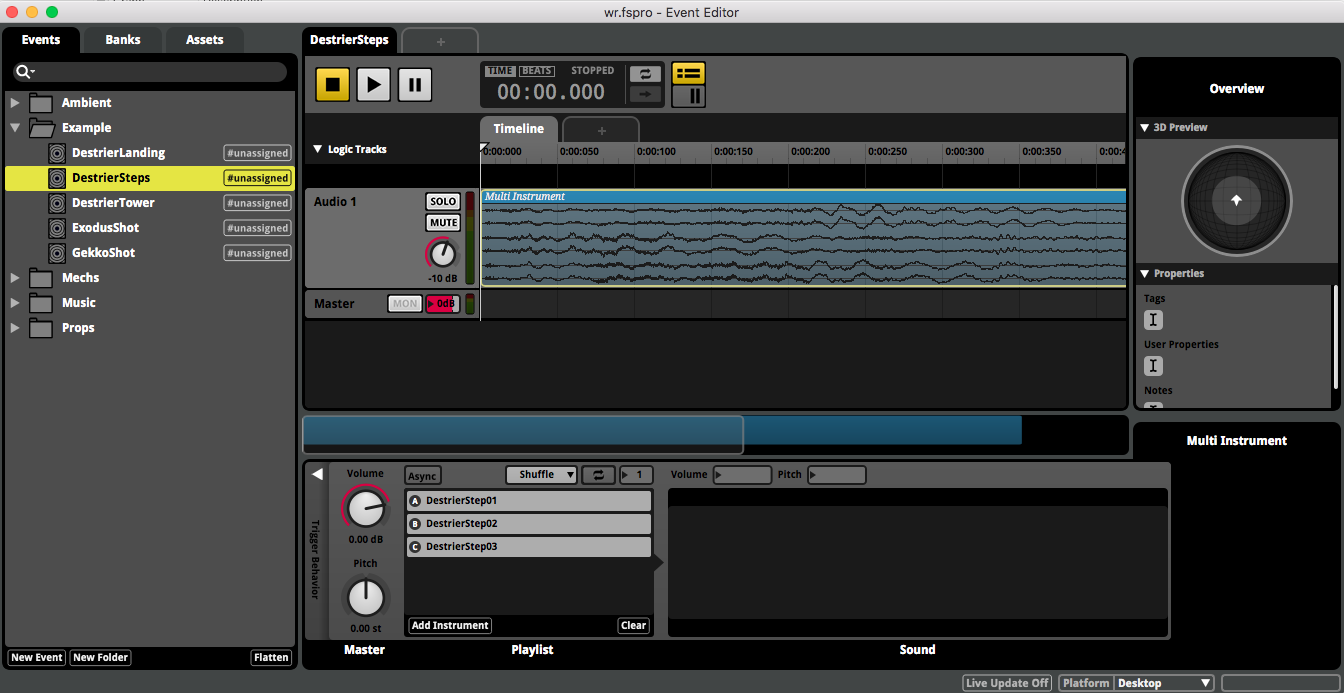Minus ears or how not to spoil the sound in the game from the very beginning

The article is about sound, but rather is addressed not to sound designers (who know everything), but to producers, PM-gam of the gaming industry and novice developers. The errors gathered here are our own experience from the times when War Robots was still a prototype in a new niche for the company.
At that time, we wanted to quickly test the idea, which affected not only the architecture or the code , but also the sound. Then the project metrics went up sharply and the first decisions could not support such a rapid growth. The team urgently took up the critical moments, and work on the sound design had to be postponed. Now we are actively developing in this direction, although many problems could have been avoided from the very beginning. What exactly - I will tell further.
')
Often, developers do not pay enough attention to the work on sound at the start and set aside for later. A small saving of time and money at the beginning is fraught with the fact that at a certain stage everything will have to be redone. This can turn into a complex and expensive process when the project is already running.
Do not think that only Novichiki is faced with this. Surely many have heard a sensational story about sound problems in Metro: Exodus. At game dev conferences, they also often talk on the topic “how we remade the sound”.
Why it happens? Let's go in order, starting with the obvious.
Attract professionals
The option “we play a modeler on the guitar, let it sound a bit too” - it won't work on a big project. To work on the game sound is not enough to be able to make beats in FL Studio or have experience working as a DJ at weddings. The development of non-linear audio is a specific area and when searching for the right specialist it is important to pay attention to the experience of working in a game dev.
Even a studio sound engineer or a person with extensive experience in the cinema is not always suitable for such a task. They will probably be able to make excellent assets, but this is not enough.
Creating sound effects is only half the task (or even less). From the sound designer you need a good knowledge of gaming and audio engines (and related tools); the ability to competently implement and optimize sound assets; understanding how the game works; concept of standards, formats and limitations. In the end, the sound designer must speak the same language with the developers and not fall into a stupor when asked to maintain a brunch, make a pull request, or prostitimetit task.
When developing a project for PCs and consoles, the complexity of working on sound increases many times and we are not talking about any remote or party time, because one full-time human orchestra is not enough (or he will soon go on indefinite leave due to professional burnout). The audio department of 5-10 people with its manager and the distribution of areas of responsibility on AAA-taytlah - quite normal. But this is a separate topic.
A person without experience can voice a prototype, but mistakes made by him at an early stage can become a serious problem in the future. If you are just starting to work on a small game and do not see the point of hiring a special employee to work on sound, it is better to find a remote designer on a project basis. The task of this person is to lay the foundation for further audio development.
But even when working remotely, the sound designer should be involved in the project and interact with game designers, artists, programmers; have access to repositories; independently work in the editor and check the playback of sounds in the game. Well, if sometimes he will participate in playtests. Ordering sounds based on text descriptions and screenshots is not the best way.
Equipment plays a big role. To complete the work, the sound designer requires really good monitors and, ideally, a specially prepared room. The famous Microlab Solo speakers, popular with the young beatmakers of the KRK Rokit, and the swag Beats headphones are not for that.
Riot Games Sound Design Basics
Use all the features of the engine
Beginner developers often use only the most basic audio features, without thinking about what is under the hood. I had to deal with projects, where all the sound is output directly to the master without a mixer and the most basic processing and with the same (maximum) volume. In this case, everything sounds too "dirty", and the details are lost in the general noise.
Meanwhile, even in the “bare” Unity there are the necessary tools and they work. You can and should use reverberation zones, filtering frequencies depending on distance, sidechain, equalization and compression.
In Unreal, an improperly tuned sound is also capable of delivering a lot of pain when finalizing, although the tools for working with audio here are quite advanced and convenient - there are classes of sounds and various patterns. But, again, the point in this is only if you use them from the very beginning.
Use middleware
Put in third place, although this is Problem Number One - this is where the root of all evil lies. When developing on Unity, using a standard engine for sound is not the best idea, because it has quite modest out-of-box capabilities. To implement many things, you need to write your own components, and there are difficulties when working with a large number of assets.

You can, of course, select programmers for audio refinement, but, in my opinion, this is difficult and expensive. Everything has been invented before us and has proven itself perfectly. The Unity audio engine is based on FMOD, and even the Unity developers themselves in the official manual recommend using FMOD Studio.
Using a third-party sound engine - Wwise or FMOD - greatly simplifies the process, removes almost all sound work from the client team and opens up wide opportunities for the sound designer, both in terms of working on sounds and in terms of optimization.
All sound settings in Unity are tied to prefabs and scenes, and the external audio library with all parameters is stored separately - changes to it do not affect the rest of the project. In addition, 90% of the work takes place in a separate editor, which is more convenient for working with audio.

FMOD Studio
A simple example. Let's say in the game on Unity there are 50 types of weapons, each with its own set of sounds. You want to change the distance of hearing at the guns. To do this, you will have to change the settings in each prefab (manually, by script or by autochange). But if someone else is working on these prefabs (for example, artists or game designers who rule the balance), version conflicts will start immediately, endless merges, additional work for QA and subsequent edits - because 5 out of 50 prefabs are lost somewhere or already poured over its version.
And if you use FMOD, then all changes can be made once in one template in a couple of minutes. Using middleware, you make the process of working on sound easier, faster and cheaper. This saves working time not only for sound designers, but also for programmers, game designers and testers.
Among opponents of this approach, there is the opinion that third-party audio engines reduce performance and increase the size of the build. Particularly wary of them are on some mobile projects, where no more than 10-20 sounds are planned. But this is not entirely correct:
- First, ten sounds quickly turn into a hundred.
- Secondly, the performance of using middleware influences in the best possible way due to the “smart” compression and wide optimization possibilities: you can separately prioritize different classes of sounds, scale the settings for each platform and track everything in a separate profiler. It also makes sense to store different types of assets in separate banks and load them only at the moment when they are used - in this way we will also save RAM.
- Thirdly, the size of the build can be reduced just by using a small number of assets and the rich capabilities of their combination and processing in the editor.
There are quite a few examples when using Wwise in games with very hard limits on the size of the build managed to make generative dynamic music using a microscopic set of basic samples.
Both sound engines - FMOD and Wwise - are free under certain conditions (one game per year with a budget of no more than $ 500,000 for FMOD, and for Wwise, a budget of $ 150,000 and no more than 500 sounds in the project). Both are fully ready to work with Unity and Unreal and connect in a few minutes.
A short but very important lecture about middleware
Do not take sounds anywhere
There are not so many high-quality sound libraries in free access and they have been used in other projects more than once. Many sounds (on the same freesound.org ) are recorded with extraneous noise or reverb. And “free” services almost always have limitations on commercial use, written in small print and valid for one in ten downloaded files.
In paid libraries, everything is not always perfect either - you can pay a decent amount and use several sounds from the whole set, and then discover that they were already in a dozen games and films. It’s easier to use subscription services that give access to the same libraries for $ 10-15 per month (for example, Soundsnap or Splice).
It is also difficult to make high-quality sound from scattered free samples or ready-made thematic sets. Ideally, the sounds are made for animation and should be uniform in nature and dynamics of sound, consistent with the general style. Therefore, when choosing libraries, it is better to focus not on ready-to-use assets, but on correctly recorded sources. In addition, it is sometimes easier to record the sound yourself than to look for a suitable option in the depths of the libraries.
Correctly evaluate the terms
There is no need to explain. Situations “it is necessary to voice ten new characters urgently, tomorrow a frieze!” - it is better to avoid. Although someone thinks that the work on the sound comes down to a simple copying of suitable samples from libraries.
It is better to pre-set the tasks of the sound designer, ask him to estimate the time and notify as the animations and FX appear, everyone will be happy.
At the start of a new project, it makes sense to start a library with empty event placers and add audio tapes to them as new content becomes available.

Audiokinetic wwise
Think about the players
Think about the players
“All the same, everyone plays without sound” - such an opinion is found among some developers of mobile projects. Indeed, some players turn off the sound (especially in public places), but many use headphones, play at home with the speakers on on a smartphone, Android-set-top box, Apple TV or computer through the Gameroom.
The audio information is processed by the brain faster than the visual, and there are quite a lot of players who need audible feedback. When they press a button, they want to hear a click; when they shoot from imba-cannon - they want to hear a big bang, otherwise they will feel that this weapon is Not Very.
The discrepancy between sound and animation timings, frequency conflicts, problems with loudness and resonances, the lack of a sound response where it should be - from such trifles there is a general impression about the game. Faced at the very beginning with the “minus-ears-sound”, the player will at best turn it off, and at worst - decide that everything else in the game is done the same way.
A satisfied user just keep silent. If the game is good with sound, in most cases no one will tell you specifically. But bad audio will certainly add negative comments.
Eventually
Errors made at the start of development will be more difficult to correct in the future. Use middleware even in the most simple projects - it will save time and money, as well as reduce the size of the build without sacrificing quality. Refer to experienced professionals from the industry, and when working on large projects, take the sound designers in the state. Respect the feelings of the players-audials. High-quality sound is no longer a luxury, but an important and necessary aspect of games. And this also applies to mobile games.
Frequently asked Questions
Q: What to read about gaming sound design?
A: See the links at the bottom, I advise you to start with the first.
Q: What software is better to use?
A: Not so important. If we are talking about DAW and plugins, use the one that is most convenient and accessible to you. Opportunities are now approximately equal everywhere, the only difference is in habits and approach. If we talk about highly specialized instruments, then you can pay attention to the products of Krotos and LeSound.
Q: How to choose between FMOD and Wwise?
A: The choice is not easy, as both candidates are very worthy. In short, Wwise has more options and a higher entry threshold, and FMOD is easier to learn and has an intuitive interface. The best option is to master both engines and use them depending on the requirements of the project.
Q: The budget does not allow you to hire even a remote sound designer for a while, what to do?
A: In any case, from the very beginning, use middleware, especially since it is free for projects with a small budget. You will not lose anything, but then it will be much easier.
Q: But you can make a good sound without middleware?
A: You can. It's just longer and harder.
Q: How important are monitors for work?
A: Very important. You can save on any other equipment, but not on monitors. The task of household speakers and headphones - to improve the sound and disguise its shortcomings, and the monitors allow you to identify all the jambs. Without them, you can do everything correctly, but you will not be able to adequately evaluate the result. No one forces you to buy Barefoot or Genelec 1238 for half a million apiece, but decent acoustics of the Adam A7X level is necessary for normal operation.
Q: Do I need to build my own studio?
A: Depends on volume. If you have sound designers in the state and they are constantly loaded with work, then your own studio will be a good decision (well, or you already have one). If the volumes are smaller, the studio is not and is not planned, and the sound designer has his own equipment and the necessary conditions, then it is better to give him the opportunity to work part time from home.
Q: How to choose the right equipment for a novice sound designer?
A: Start with monitors, good sound card, midi keyboard and recorder. For a start, the budget Zoom H1 is also suitable, but you should order a windshield and shockmount on Aliexpress. Upgrade equipment should be as it will generate income and when you encounter restrictions and understand what and why you need to replace.
Q: What activities are worth a visit or see in the record?
A: GDC, GameSoundCon, DevGamm, 4C, Waveforum, AES International.
Links
- griaudio.ru - GRIA (Guild of Interactive Audio Developers).
- www.youtube.com/user/FMODTV - official FMOD lessons.
- www.youtube.com/user/AudiokineticWwise - Wwise official lessons.
- www.youtube.com/watch?v=jVac5IFXpFo&list=PLgcjKJC9_js9hpkYKGRmAv5o2Nc0hwB_l - GDC sound design lectures.
- www.somatone.com/7-reasons-why-mobile-game-devs-should-use-wwise - 7 reasons to use Wwise in mobile development.
- theaudiospotlight.com - The Audio Spotlight.
- designingsound.org - Designing Sound.
- www.thesoundarchitect.co.uk - The Sound Architect.
- blog.prosoundeffects.com - Pro Sound Effects.
- www.asoundeffect.com - A Sound Effect.
- www.gamasutra.com/category/audio - Gamasutra / Audio.
- soundcloud.com/ilyaorange - author's modest soundcloud.
Source: https://habr.com/ru/post/455242/
All Articles